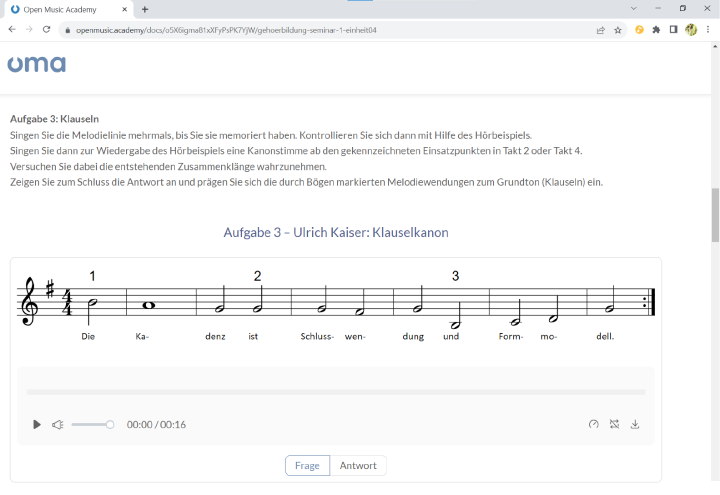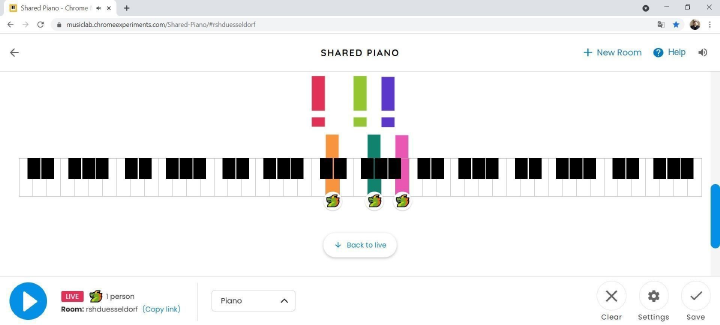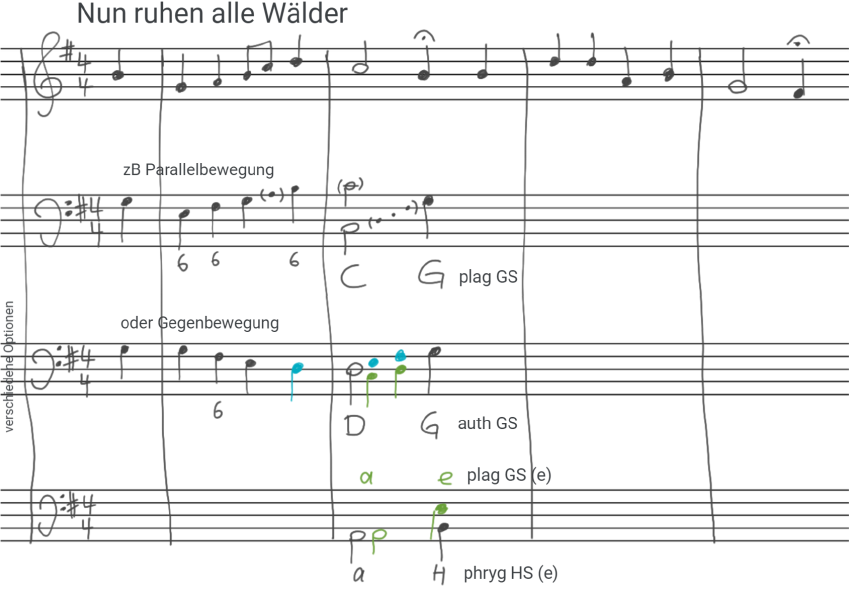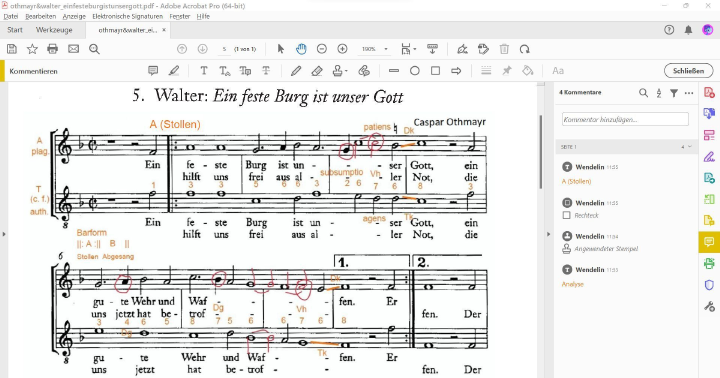The Digital Music Theory Classroom
Considerations for Technology-Based Teaching at Music Universities
Wendelin Bitzan
This article outlines a concept for teaching music theory to undergraduate or graduate students based on the application of digital media, online platforms, and collaborative tools and documents. Two different strategies of realization are suggested, varying with regard to contact time and course organization: a blended learning approach and a combined face-to-face and flipped classroom scheme, both comprising a mixture of on-site instruction, remote teaching, and asynchronous e-learning units.
Dieser Beitrag präsentiert ein Konzept für den Musiktheorieunterricht, das auf dem Einsatz von digitalen Medien, Online-Plattformen und kollaborativen Dokumenten basiert. Zwei verschiedene Strategien der Realisierung werden vorgestellt, die sich im Hinblick auf die Organisation der Lehrveranstaltungen unterscheiden: ein Blended-Learning-Modell und ein Ansatz, der flexible Kontaktphasen und Inverted-Classroom-Einheiten kombiniert. Beide Wege sind geprägt durch eine Mischung aus Präsenz- und Online-Unterricht und können durch asynchrone E-Learning-Phasen ergänzt werden.
In this article I will propose a concept for teaching music theory to classes of undergraduate or graduate students at universities, conservatories, or music schools, based on the application of digital media, online platforms, and collaborative tools and documents.[1] The concept includes two different approaches to realization, varying with regard to contact times and application of digital media: a blended learning approach[2] (see strategy A in the concluding overview in Table 2) and a combined face-to-face and flipped-classroom scheme[3] (strategy B). While both strategies employ a mixture of on-site instruction, remote teaching, and asynchronous e-learning units, strategy A is primarily designed for lectures and courses with theoretical content, while strategy B appears more suitable for classes with prevailing practical activity. The materials introduced in the concept make substantial use of open educational resources (OER), while the methods and routines of their application may be considered open educational practices (OEP).[4]
It should go without saying that the methodology presented here reflects my personal convictions and predilections. It neither claims to be a best-practice model, nor do I think that the concept is applicable for every subject, topic, or teaching scenario in the broad field of music theory. However, I believe that it might be useful for colleagues and fellow instructors to take note of the following thoughts. Should readers find inspiration in this article, or feel inclined to discuss the concept or any of its components further, they are most welcome to get in touch.
Teaching Methodology
The concept outlined below is based on ideas and methodological considerations from the time when face-to-face teaching was impossible during the Covid-19 pandemic. However, many of the strategies first introduced in an entirely remote, video-conference setting proved to be equally suitable for on-site or hybrid teaching — so I maintained and refined my ideas for further application, culminating in a versatile blended learning approach convenient for multiple teaching scenarios. Thus far, students have appeared largely appreciative of the concept, acknowledging its methodological diversity and flexibility in terms of temporal and local organization of classes in several teaching evaluations using the TAP method (teaching analysis poll) in 2022–23.
The concept is based on the following premises and core elements:
There should be no significant differences in content between on-site and remote teaching. Switching from one format to the other needs to function seamlessly and without organizational obstacles, so a common teaching platform or learning management system is used to make syllabi, worksheets, and all other materials available at all times. I use a combination of MS Teams for Education and Moodle, the platforms provided by my institution (Robert Schumann Hochschule Düsseldorf), both of which are available as desktop and mobile apps, as well as on the web browser.[5] The total amount of remote sessions should ideally not exceed 50 % of the course; in any case, the first and last session of a class, and the sessions directly preceding an exam, should be held in-person.
The classes are accompanied by a series of self-training assignments, one exercise per week, of which roughly 50 % are expected to be turned in for successful completion of the course. Students are not required to complete the assignments within one week or before the next session takes place, but are free to continue working whenever they can manage it, throughout the semester. With the assignment functions of platforms such as MS Teams or Google Classroom[6], students can retrieve, edit, and turn in their exercises at any time. Subsequently, the instructor can submit feedback and assessments via the same platform.
An essential component is the usage of collaborative cloud documents, accessible by students and teachers both synchronously and asynchronously. In this manner, collective coursework (for example, the compiled notes of a whole semester in a text document,[7] or a series of whiteboard pages with annotated scores or composition exercises) is gathered as sort of a virtual apparatus for the class.[8] When teaching on-site, students have the opportunity to access and edit the cloud documents via shortened URLs, and simultaneously follow other persons’ editing of the same document projected on the wall. This is a very similar procedure as in remote classes, in which students would open the respective document in a separate browser window, thus transferring a method from online teaching to an on-site setting. As an instructor, I appreciate the opportunity to move around the classroom with my tablet while taking notes or fill in elements of a worksheet while I demonstrate something at the MIDI keyboard or acoustic piano. Collaborative documents also enable students to continue working later and to complete assignments on their own (using different methods from flipped-classroom teaching), or to have their work exchanged and peer-assessed with and by their classmates.
In lectures and classes focusing on analysis or historical composition, interaction with students during remote teaching is generally possible without significant constraints. My experience from the past three years suggests that the frequency of attendance tends to be higher in remote classes, as compared to on-site teaching. Thus, alternating between in-person and online sessions, as in strategy A, does not cause a loss of teaching quality, but rather offers benefits in methodology and available forms of interaction. However, in aural skills classes that are more dependent on practical work and active recapitulation in class (for example, in exercises that require playing and singing back as a group, or in score-reading and prima vista exercises),[9] face-to-face teaching is hardly replaceable. Nevertheless, teaching aural skills may also benefit from online tutorials (see Fig. 1) and flipped-classroom activities in addition to the on-site sessions, as in strategy B. In all of the mentioned formats, my teaching is supplemented with self-devised tutorials and open educational resources.[10]

Figure 1: Screenshot from the Open Music Academy, showing an aural skills tutorial (exercise by Ulrich Kaiser)
Technical Requirements and Setup
The concept will work with minimal equipment of just one touchscreen device per student (convertible computer or tablet with WiFi connection). Should none of these be available, students may also be able to participate in on-site teaching with only their smartphones, which at least enable them to join in working on collaborative documents. The instructor, however, is required to use extended equipment and to demonstrate competences in operating the relevant software for the devices in use.[11] A desirable configuration to work smoothly would account for one of the following setups:
Table 1: Technical requirements for hybrid and remote teaching setups
My preferred setup is to operate two monitors on the computer used for teaching, with the primary screen displaying the software needed for teaching and holding the class (teaching platform or learning management system, conceptual notes and scripts, and video conferencing client for strategy A; see Fig. 2), while the secondary screen transmits all required information to the students via a projector (on-site) or via screen-sharing in the video conferencing client (in remote or hybrid settings). Working with dual screens and extending the desktop over both enables the instructor to quickly slide a window from the primary to the secondary screen, if needed. Most of the windows, though, will reside on the second screen and remain visible to the students when focused, so switching between collaborative documents, virtual whiteboards, browser-based tutorials, or score writing software is easily achievable at any time. Music can be played back through the classroom speakers from audio recordings, via MIDI output from the teacher’s computer, or by using an acoustic instrument.

Figure 2: Dual screen setup for strategy A, with primary screen on the left (video conferencing software, conceptual notes) and shared secondary screen on the right (learning management system, collaborative documents, and virtual keyboard)
In most teaching scenarios, the BYOD principle (bring your own device) is applicable, so students will use the equipment that they have at home or would usually carry in their bags. However, for face-to-face classes relying on musical interaction, such as aural skills, keyboard practice, or improvisation courses, it is desirable to provide every student with a touchscreen device of 8–9 inches minimum and a MIDI keyboard. This will enable them to work and play together in the classroom either acoustically, using their device outputs or additional physical speakers, or virtually, operating an on-screen keyboard in a browser window (such as MultiPlayerPiano or SharedPiano from the Chrome Music Lab;[12] see Fig. 3) with the audio output routed to their headphones. If MIDI instruments are not available or not for every member of the class, a virtual piano can also be operated from a touchscreen or computer keyboard with certain limitations.

Figure 3: Screenshot from SharedPiano, a collaborative keyboard application from Chrome Music Lab
At this point, hardly any restrictions should remain for students to participate efficiently in remote or hybrid classes. Slow or unreliable internet connections in the students’ private apartments may impede running data-intensive applications — a possible solution to this problem could be to authorize students to join an online class on-site, using an available classroom with headsets to avoid crosstalk and other audio issues. Universities might also have separate media labs with multiple workstations that can be employed for such purposes.
Some other problems associated with remote teaching that the present article does not discuss in detail include the higher potential of distraction (especially when students join a remote session without turning their camera on), the limited means of nonverbal communication, and the possible lack of direct and individual feedback for the instructor. At any rate, the tendency that online lecturing might, in some settings, be more prone to traditional teacher-centered methodology and top-down transfer of knowledge may be met with deliberate application of collaborative tools and group work, which can be carried out in breakout rooms during video meetings.
Digital Exams and E-Tests
During Covid-19, many universities made examination routines more flexible so as not to rely on in-person formats.[13] At some institutions, others than the prescribed types of exams were introduced, for example, written tests taking place during video meetings; also, on-site tests or oral exams were replaced with asynchronous solutions, such as independently prepared coursework or term papers. At my university, the latter type has been consolidated and implemented in the examination regulations, resulting in no need to return to face-to-face exams in every case. It turned out that students, when offered a choice, clearly preferred those remote options over traditional tests, regardless of the teaching formats (strategies A or B) applied in the course. Synchronous e-tests can be conducted partly offline (by printing out worksheets, filling them in on paper, and digitizing them again before turning in) or fully online (by using examination routines in learning management systems,[14] or by editing the worksheets using PDF readers or image processing software). In my experience, asynchronous written tests, realized by having the students complete a set of assignments on their own over a couple of days, were even more popular among students, as the time constraints associated with synchronous tests become irrelevant. Thus, asynchronous tests tend to bring about better grades and results that more appropriately represent the students’ competences. Cheating attempts are, in my experience, less likely and easier to determine in exams that demand a creative output, compared to exams in non-musical subjects. If desired or required by institutional regulations, students can also be deterred from cheating by having them sign a good-practice statement and declaration of originality, as are familiar from research term papers.
Considerations for Specific Classes
Most teaching scenarios from the field of music theory can be realized online to some extent, with varying degrees of remote instruction. There are some challenges, nonetheless, depending on how much musical interaction is required from the students. Yet for the following subjects and types of classes, remote teaching may be considered a valid enhancement, if not an equivalent, to in-person instruction. It might even offer methodological benefits that are not possible to achieve in the classroom, such as interactive digital quizzes or group work in flexible constellations, realized with breakout rooms. Here is a list of classes that I taught under the conditions described above:
Elementary Music Theory – lecture and tutorial
Course content: Music notation, tonal systems, intervals, scales, chords, instrumentation, score reading.
Activities and methodology: Transfer of knowledge via face-to-face presentation or online tutorials; exercises focusing on the interrelation between music notation and the resulting sound; deepening of the acquired understanding of content through vocal and keyboard practice; self-evaluation by taking quizzes and written tests (with or without peer assessment).[15]
Historical Composition – seminar or group tuition
Course content: Exploration of historically relevant genres, forms, and compositional techniques.
Activities and methodology: Collaborative, in-person work, applied to composition exercises (see Fig. 4 for an example from a synchronous class dedicated to chorale harmonization); students independently continue and complete their assignments at a later time; online and offline activities take place on the same platform and with the same collaborative documents or score writing tools.

Figure 4: Screenshot of a composition exercise aimed at writing a bass voice to a given chorale melody, realized on a collaborative whiteboard (colors indicate different students’ contributions that were compared in class)
Music Analysis and Musical Form – seminar or group tuition
Course content: Multi-perspective examination of musical scores, acquisition of analytic terminology.
Activities and methodology: Collective annotation of digital sheet music by using virtual whiteboards (see Fig. 5 for an example from a counterpoint class aimed at the analysis of Renaissance bicinia); sharing and discussion of different visualizations, such as timeline diagrams and analytical graphs; gradual completion of a course portfolio stored in collaborative documents. Students can also be encouraged to use their results to enhance and further develop existing materials as an OEP, or to design their own worksheets and tutorials in order to create new teaching resources.

Figure 5: Screenshot from Adobe Acrobat while live-editing a PDF score with analytical annotations (source: Daniel, Thomas. 1997. Kontrapunkt. Eine Satzlehre zur Vokalpolyphonie des 16. Jahrhunderts, Notenbeiheft. Cologne: Dohr)
Aural Skills and Ear Training – practice tutorial
Course content: Improvement of interior hearing, auditive imagination, and musical memory.
Activities and methodology: Listening and notation exercises, focusing on melody, harmony, rhythm, and musical form; sight-reading exercises; polyphonic music-making while listening (on-site and remotely, carried out on a collaborative on-screen keyboard).
Final Remarks
As a conclusion, I would like to emphasize that, in teaching music theory, I find it indispensable to have a significant share of in-person instruction. This pertains in particular to the training of aural skills, and to subjects that require practical comprehension through playing or singing together. There is, however, no need to have all classes taught exclusively and continually on-site, as some university administrations have tended to enforce when this became possible again after Covid-19. From my point of view, this should not be mandatory, neither from the perspective of professional and media didactics, nor from an organizational perspective. Conversely, a focused and well-considered implementation of remote and hybrid teaching formats appears to be both feasible and expedient, given the ever-growing familiarity of students with technology, digital media, and e-learning routines, and considering the availability of the vast experience and individual routines acquired by faculty during the period of compulsory online teaching. If introduced in a responsible and considerate manner, technology-based teaching allows the instructor to take a step back behind their educational objective, while “technology not only assumes an intermediary function, but is at the same time a carrier of content, assignments, and values.”[16]
Many of the abovementioned methods and techniques can be engaged as an enhancement to on-site classes and may be applied with great benefit for future syllabi and curricula. Therefore, I would encourage everyone to experiment with some of the strategies outlined here, and to pursue one’s personal approaches to incorporate suitable media, hardware, and software in their classes in order to devise their individual teaching concepts.
Table 2: Overview: Guidelines for the Digital Music Theory Classroom
Notes
Collaborative learning by using digital tools and platforms in the classroom has been widely discussed in academia. For some general considerations on technology-based teaching and multimedia, applied with the objectives of allowing students “to become engaged in their learning […] and increase interest and motivation” (Courts/Tucker 2012, 125), as well as promoting interactive and innovative learning, see Salter et al. 2013. | |
Blended learning is regarded as a combination of different methods and media in teaching. It is mostly defined as a mixture of face-to-face instruction and e-learning, which aims at the most efficient achievement of an educational objective (Bendel 2021). For contextualization of blended learning in academic music theory, see Kaiser 2023. | |
Flipped (or inverted) classroom is considered as a method to have students engage in self-responsible learning as “information transfer is handled outside class […], so that class time can be devoted to active student work” (Shaffer/Hughes 2013). Some general models of flipped-classroom activity in music theory teaching include the “basic flip”, just-in-time teaching, peer instruction, and inquiry-based learning. (Ibid.) | |
OER are, according to the UNESCO definition, teaching or research materials in any format and medium, available in the public domain or under an open license, that enable free access, adaptation, and further use and dissemination for various purposes. https://www.unesco.de/bildung/open-educational-resources (20 July 2024). OEP are understood as practices such as “collaborative scenarios, models, formats, and frameworks in which educational actors use, develop, and enhance OER to make them accessible to others” (Bundesministerium für Bildung und Forschung 2022). | |
https://www.microsoft.com/de-de/education/products/teams (20 July 2024). I am aware of data protection and digital security issues that are being discussed in association with the mentioned platforms and learning management systems, but I will not take into account these issues within the limited scope of the present article. | |
https://chromewebstore.google.com/detail/google-classroom/mfhehppjhmmnlfbbopchdfldgimhfhfk (20 July 2024) | |
Recommendable free-to-use platforms, besides the omnipresent Google Docs, are Etherpad, Cryptpad, or Hypothesis. https://cryptpad.fr; https://etherpad.org; https://web.hypothes.is/ (20 July 2024) | |
Collaborative whiteboard apps or websites include Miro, Conceptboard, the whiteboard integrated in Zoom, and many more. Simultaneous score writing activities involving multiple persons are possible on the website Flat.io; see the review in Kersten 2020. https://miro.com/de/; https://conceptboard.com; https://zoom.us; https://flat.io/edu (20 July 2024) | |
Some thoughts on teaching keyboard practice in remote aural skills classes can be found in my German-language video lecture “Hören, Spielen, Reflektieren”, presented in May 2021 in an online seminar of the European Piano Teachers Association. https://www.youtube.com/watch?v=PV826xuaA-4 (20 July 2024) | |
See my tutorial series on the OER platform Open Music Academy, for instance, courses in musical form and aural skills. https://openmusic.academy; https://openmusic.academy/revs/8N4mZkNDyU5BZ3gEZsT3fy; https://openmusic.academy/revs/3RGxB7jJhf3rRujeDBLN2s (20 July 2024). More of my own materials for different topics and fields of music-theoretical teaching are available on my website: https://wendelinbitzan.de/teaching/teaching-resources (20 July 2024). Other online resources with plenty of material for music theory classes include https://www.musictheory.net, https://teoria.com, and https://www.artusimusic.com (20 July 2024). | |
See Kaiser 2023, 340 and 344, for an overview of instructors’ competences and technical requirements (projector or smartboard, tablet, MIDI keyboard, headphones) associated with designing syllabi, preparing materials, and implementing blended learning assignments and units. | |
https://multiplayerpiano.com; https://musiclab.chromeexperiments.com/Shared-Piano/ (20 July 2024) | |
Online tests can be set up in Moodle, ILIAS or Google Classroom. Quizzes can be designed with the help of interactive H5P elements, available in most learning management systems, or with MS Forms via MS Teams. https://moodle.com; https://www.ilias.de; https://h5p.org; https://www.microsoft.com/de-de/microsoft-365/online-surveys-polls-quizzes (20 July 2024) | |
Detailed specifications for remote examination can be found, for example, in the study guidelines of the Royal Conservatory of Music, Toronto: https://www.rcmusic.com/learning/examinations/remote-exams/remote-theory-exams (20 July 2024) | |
An elaborate approach to group discussion and peer assessment in musical analysis has been introduced by Leupold and Snodgrass (2014), who conducted two separate studies with two learning groups. The results of the studies indicated that students “were interested to learn from each other”, “alternate[d] between the teacher and student role” with benefit, and achieved “a deeper understanding of the composition because of the collaborative nature” of the project. | |
Ahner 2019, 7. |
References
Ahner, Philipp. 2019. “E-Learning in Musikschulen: Zwischen Freiräumen, persönlichem Kontakt, anonymen Online-Kursen und inhaltlicher Vorbestimmtheit.” Üben & Musizieren 37/1, 6–9. https://uebenundmusizieren.de/artikel/e-learning-in-musikschulen/ (22 July 2024)
Bendel, Oliver. 2021. “Blended Learning.” In Gabler Wirtschaftslexikon. https://wirtschaftslexikon.gabler.de/definition/blended-learning-53492/version-384383 (25 May 2024)
Courts, Bari / Jan Tucker. 2012. “Using Technology to Create a Dynamic Classroom Experience.” Journal of College Teaching & Learning 9/2: 121–127.
Bundesministerium für Bildung und Forschung, ed. 2022. OER-Strategie: Freie Bildungsmaterialien für die Entwicklung digitaler Bildung. https://www.bmbf.de/SharedDocs/Publikationen/de/bmbf/3/691288_OER-Strategie.html (25 May 2024)
Kaiser, Ulrich. 2023. “Blended Learning im Musiktheorieunterricht.” In Notation. Schnittstelle zwischen Komposition, Interpretation und Analyse. 19. Jahreskongress der Gesellschaft für Musiktheorie, Zürich 2019, edited by Philippe Kocher, 333–345. https://doi.org/10.31751/p.270
Kersten, Fred. 2020. “Flat: Online Collaborative Music Notation Software.” College Music Symposium 60/2. https://www.jstor.org/stable/26989796 (25 May 2024)
Leupold, John / Jennifer Snodgrass. 2014. “Concurrent Collaborative Analysis: Integration of Technology for Peer-Learning”. College Music Symposium 54. https://www.jstor.org/stable/26574358 (25 May 2024)
Salter, Diane / David L. Thomson / Bob Fox / Joy Lam. 2013. “Use and Evaluation of a Technology-Rich Experimental Collaborative Classroom.” Higher Education Research & Development 32/5: 805–819. https://doi.org/10.1080/07294360.2013.777033
Shaffer, Kris / Bryn Hughes. 2013. “Flipping the Classroom: Three Methods.” Engaging Students: Essays in Music Pedagogy 1. http://flipcamp.org/engagingstudents/shafferintro.html (25 May 2024)
Robert Schumann Hochschule Düsseldorf
Dieser Text erscheint im Open Access und ist lizenziert unter einer Creative Commons Namensnennung 4.0 International Lizenz.
This is an open access article licensed under a Creative Commons Attribution 4.0 International License.

